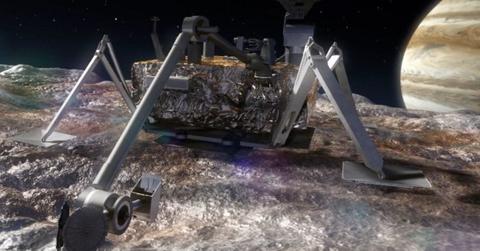NASA's Cosmic Quest: Diving into the Icy Depths of Jupiter's Moon in Pursuit of Extraterrestrial Life

NASA has revealed how it will land on the icy ocean of Jupiter's moon Europa to search for signs of life in a proposed mission.
Feb. 1 2024, Published 12:01 p.m. ET
NASA has shared their plan for landing on a moon of Jupiter in an effort to find any evidence of life.
The space agency is considering a mission to land on the frozen surface of Europa following a scheduled flyby later this year.
According to NASA's webpage for the project, even though the "Europa Lander" is now only "a concept for a potential future mission," the agency is actively working on plans for its implementation.
The agency is now using the Jet Propulsion Laboratory in Southern California to test the spacecraft's landing gear. The goal is to land on the moon and gather samples in order to look into the possibilities of finding evidence of life in Europa's surface material.
The proposed robotic lander would drill approximately 4 inches into the ice crust, deep enough to access materials shielded from Jupiter's damaging radiation.
The collected samples would then undergo analysis in a "miniature laboratory" within the spacecraft, similar to how samples on Mars have been studied by landers and rovers, NASA said.
In addition to sample collection, NASA envisions equipping the mission with a microscope, camera and seismometer to identify geologic activities such as eruptions or shifts within Europa's ice crust.
Photos of the mission's landing gear have surfaced, displaying strong metal legs built to withstand a forceful touchdown. These landing gear components will be tested by engineers on a platform that replicates the surface conditions of Europa.
Scientists believe that beneath its frozen exterior, Europa harbors a vast salty ocean that contains the necessary elements for life, including energy, chemistry and water. Biosignatures, which are suggestive of possible life, may reach the surface, according to NASA.
Meanwhile, a thorough exploration of the ice moon will begin later this year with the Europa Clipper mission.
Never miss a story — sign up for the Front Page Detectives newsletter. Be on the scene the moment news breaks.
Without touching down, this solar-powered spacecraft will circle Jupiter and make nearly 50 flybys of Europa to evaluate the conditions that could support life. Launched in October, the Europa Clipper is expected to reach Jupiter in 2030.
NASA's Europa webpage states that, with over 90 moons around Jupiter, Europa — the sixth-closest moon — stands out as a promising possibility for perhaps hosting modern conditions suitable for extraterrestrial life.
Become a Front Page Detective
Sign up to receive breaking
Front Page Detectives
news and exclusive investigations.
